#Evolutionary traits
Explore tagged Tumblr posts
Text
"Unraveling the Human Tapestry: Frank Hamel's 'Human Animals'—A Journey into the Complex Nature of Humanity"
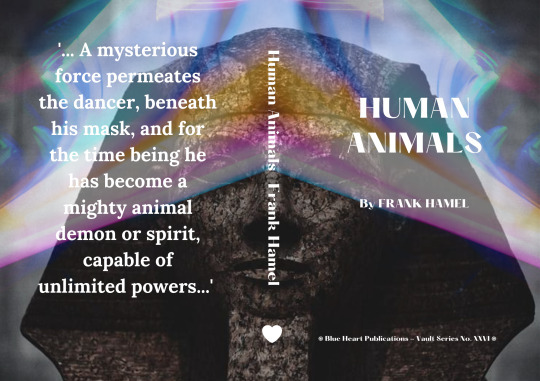
Frank Hamel's "Human Animals" is a thought-provoking exploration of the intricate interplay between our human nature and the animal instincts that reside within us. This fascinating journey into the realms of biology, psychology, and societal constructs unfolds with a narrative precision that both challenges and enlightens. The title itself serves as a prelude to a comprehensive examination of the dualities that define our existence—a title that hints at the untamed aspects of our being, waiting to be unraveled.
Published in [Year], "Human Animals" is a testament to Hamel's keen intellectual curiosity and his ability to distill complex concepts into a narrative accessible to a broad audience. The title alludes to the central theme—the recognition that beneath our veneer of civilization, there exists a primal essence shared with our fellow creatures in the animal kingdom.
Hamel's exploration begins with a scientific lens, dissecting the biological similarities between humans and other animals. The opening chapters lay the groundwork for understanding our shared ancestry, evolutionary traits, and the genetic links that bind us to the broader animal kingdom. The title "Human Animals" becomes a guide through this scientific inquiry, inviting readers to reconsider their perception of human uniqueness.
Beyond the biological, Hamel delves into the psychological dimensions of our shared humanity. He navigates the complexities of human behavior, emotions, and social structures, drawing connections between our actions and those observed in the animal world. The title encapsulates this psychological journey, suggesting that within our societal constructs, there exist primal instincts that shape our behaviors.
Hamel's writing is not merely an academic discourse; it is a bridge between the scientific and the philosophical. The narrative is enriched by anecdotes, case studies, and historical examples that add a human touch to the exploration. The title serves as a thematic compass, signaling to readers that they are embarking on a nuanced exploration of what it means to be human, entwined with our animalistic roots.
As the book progresses, Hamel ventures into the ethical considerations surrounding our treatment of animals and the environmental impact of human activities. The title becomes a poignant reminder of the responsibility we bear as stewards of the planet, urging readers to reflect on the consequences of our actions on the delicate balance of the natural world.
"Human Animals" is not just an examination of our shared biological heritage; it is a call to introspection and societal self-reflection. Hamel challenges preconceived notions, inviting readers to confront uncomfortable truths about the intersections of humanity and animality. The title, with its enigmatic allure, guides readers through a labyrinth of ethical contemplation.
In conclusion, "Human Animals" by Frank Hamel is a captivating exploration that transcends disciplinary boundaries. The title encapsulates the essence of the book—a multifaceted exploration of the intricate connections between humanity and the animal kingdom. Hamel's prose is engaging, his ideas are profound, and the title acts as an evocative portal into the depths of our shared nature. As readers journey through the pages, "Human Animals" leaves an indelible impression, challenging us to peel back the layers of societal conditioning and reevaluate our place within the vast tapestry of the natural world.
Frank Hamel's "Human Animals" is available in Amazon in paperback 15.99$ and hardcover 23.99$ editions.
Number of pages: 399
Language: English
Rating: 9/10
Link of the book!
Review By: King's Cat
#Frank Hamel#Human Animals#Biological similarities#Animal instincts#Dualities of existence#Evolutionary traits#Genetic links#Animal kingdom#Scientific exploration#Primal essence#Shared ancestry#Psychological dimensions#Human behavior#Social structures#Societal constructs#Human uniqueness#Philosophical inquiry#Anecdotes#Case studies#Historical examples#Ethical considerations#Environmental impact#Stewards of the planet#Consequences of actions#Delicate balance#Responsibility#Call to introspection#Societal self-reflection#Challenging preconceived notions#Uncomfortable truths
5 notes
·
View notes
Text
"Unraveling the Human Tapestry: Frank Hamel's 'Human Animals'—A Journey into the Complex Nature of Humanity"
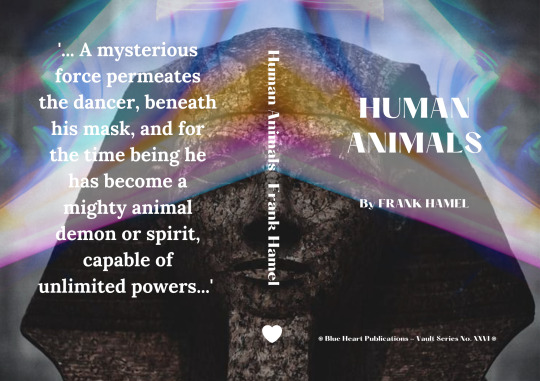
Frank Hamel's "Human Animals" is a thought-provoking exploration of the intricate interplay between our human nature and the animal instincts that reside within us. This fascinating journey into the realms of biology, psychology, and societal constructs unfolds with a narrative precision that both challenges and enlightens. The title itself serves as a prelude to a comprehensive examination of the dualities that define our existence—a title that hints at the untamed aspects of our being, waiting to be unraveled.
Published in [Year], "Human Animals" is a testament to Hamel's keen intellectual curiosity and his ability to distill complex concepts into a narrative accessible to a broad audience. The title alludes to the central theme—the recognition that beneath our veneer of civilization, there exists a primal essence shared with our fellow creatures in the animal kingdom.
Hamel's exploration begins with a scientific lens, dissecting the biological similarities between humans and other animals. The opening chapters lay the groundwork for understanding our shared ancestry, evolutionary traits, and the genetic links that bind us to the broader animal kingdom. The title "Human Animals" becomes a guide through this scientific inquiry, inviting readers to reconsider their perception of human uniqueness.
Beyond the biological, Hamel delves into the psychological dimensions of our shared humanity. He navigates the complexities of human behavior, emotions, and social structures, drawing connections between our actions and those observed in the animal world. The title encapsulates this psychological journey, suggesting that within our societal constructs, there exist primal instincts that shape our behaviors.
Hamel's writing is not merely an academic discourse; it is a bridge between the scientific and the philosophical. The narrative is enriched by anecdotes, case studies, and historical examples that add a human touch to the exploration. The title serves as a thematic compass, signaling to readers that they are embarking on a nuanced exploration of what it means to be human, entwined with our animalistic roots.
As the book progresses, Hamel ventures into the ethical considerations surrounding our treatment of animals and the environmental impact of human activities. The title becomes a poignant reminder of the responsibility we bear as stewards of the planet, urging readers to reflect on the consequences of our actions on the delicate balance of the natural world.
"Human Animals" is not just an examination of our shared biological heritage; it is a call to introspection and societal self-reflection. Hamel challenges preconceived notions, inviting readers to confront uncomfortable truths about the intersections of humanity and animality. The title, with its enigmatic allure, guides readers through a labyrinth of ethical contemplation.
In conclusion, "Human Animals" by Frank Hamel is a captivating exploration that transcends disciplinary boundaries. The title encapsulates the essence of the book—a multifaceted exploration of the intricate connections between humanity and the animal kingdom. Hamel's prose is engaging, his ideas are profound, and the title acts as an evocative portal into the depths of our shared nature. As readers journey through the pages, "Human Animals" leaves an indelible impression, challenging us to peel back the layers of societal conditioning and reevaluate our place within the vast tapestry of the natural world.
Frank Hamel's "Human Animals" is available in Amazon in paperback 15.99$ and hardcover 23.99$ editions.
Number of pages: 399
Language: English
Rating: 9/10
Link of the book!
Review By: King's Cat
#Frank Hamel#Human Animals#Biological similarities#Animal instincts#Dualities of existence#Evolutionary traits#Genetic links#Animal kingdom#Scientific exploration#Primal essence#Shared ancestry#Psychological dimensions#Human behavior#Social structures#Societal constructs#Human uniqueness#Philosophical inquiry#Anecdotes#Case studies#Historical examples#Ethical considerations#Environmental impact#Stewards of the planet#Consequences of actions#Delicate balance#Responsibility#Call to introspection#Societal self-reflection#Challenging preconceived notions#Uncomfortable truths
0 notes
Note
A question for the fairies! Why do y'all have legs if you float everywhere? Is it some kindof evolutionary leftover? Or to be more familiar to humans? (Btw I love your series/headcanons, and I love the designs of everyone!)
The reason they have legs is becau-

Oh! Yeah, sure, ok. Go ahead, Cosmo.


....
Well you heard it here folks!!!! Right from the source!!
Bitties Series: [Start] > [Previous] > [Next]
#fairly oddparents#fop#fop a new wish#fop cosmo#cosmo#asks#itty bitties fop au#stephanweaverofworlds#....i think cosmo got a bit of stage fright there.#hrm.#WELL ANYWAYS#fairies are a parasitic sort of creatures. they require high levels of mimicry in order to survive and thrive.#legs were an evolutionary trait to make them more appealing to humans- a prey that makes a majority of their diet.#a bit like how carnivore flowers release sickly sweet smells to attract flies!
434 notes
·
View notes
Text
Wisdom teeth growing in again and i have such an overwhelming urge to bite things

17 notes
·
View notes
Note
"Yes, safe; not once or twice will the vampyre's attack have sufficient influence on your mortal frame, as to induce a susceptibility on your part to become coexistent with such as he. The attacks must be often repeated, and the termination of mortal existence must be a consequence essential, and direct from those attacks, before such a result may be anticipated."
"Indeed, much later we will learn that it is possible to speedrun this process in a single night; it would seem that dying of a vampire bite is the real catalyst, not the amount of bites received."
So I don't know by the time of that writing how well-known Eastern European folklore was. But yes the creation of a vampire that has been preyed upon -instead of by other means- is not something that happens upon getting bitten once (vs modern portrayals of werewolves and vampires getting turned by one bite after days pass.) Turning after dying as a result of many bites is a common rule (this is true too in 'The Vampyre' by Stagg and 'Carmilla').
But the "years" mentioned isn't something that I have seen beyond one source w/o refs, that a Romanian vampire may need seven years to devour his family and then the village, but 7 is just one of those recurring numbers (e.g a strigoi needs to remain undetected for 7 years and after this, it will be able to travel anywhere without restrictions and blend in as human, and that's why villagers would open a grave 3 and 7 years after an adult's death to check) (infants and children would be victims more often but they cannot turn, only adults can)
But yes he's (mostly) following common lore.
I am sure Rymer is pulling the "years" thing out of his ass; the man has a WILD sense of time, and seeing as he thinks vampires come from Scandinavia I think it's safe to assume he doesn't know any Romanian folklore beyond what's trickled into the popular culture of his day.
The human characters in the story seem to accept as a given that death is a prerequisite for becoming a vampire, although most of them seem to think that any death will do the trick, so long as the person was bitten at some point. (See: Marchdale's grisly speculations about Flora turning. We'll also see similar sentiments turn up among the local townsfolk later.) But although the idea of turning from one bite is raised as an anxiety within the story, it isn't actually true by the (admittedly inconsistent) lore. That seems to have been an idea popularized in modern times; I have no sources for this, but I wonder if the concept grew out of our increased understanding of disease. Modern zombie media certainly has a strong motif of contagion and disease, and perhaps other types of supernatural creatures have followed suit--conceptualizing conditions such as vampirism or lycanthropy as supernatural bloodborne diseases. You can see the seeds of this idea in Dracula, actually, with Dracula feeding Mina his blood in order to turn her.
#varney the vampire#ask#lore#meta#this is a rymer hate blog#the way scientific understanding of the world trickles into fantasy is fascinating to me#the entire way we look at things like vampires has changed#ideas like venomous saliva and vampires having preferences based on blood type are common today#but they're based on an understanding of biology people in the past didn't have#or wanting to come up with a scientific justification for classic vampire weaknesses#like castlevania's ''vampires are weak to right angles'' thing which is a pet peeve of mine#the need to explain and to unpack how something works#or to explain a trait of a supernatural creature in terms of evolutionary advantage#ideas and ways of approaching fiction which straight up did not exist before a certain point in history#this is not a very coherent tag ramble idk
8 notes
·
View notes
Text
Theories of Personality
Theories of personality aim to explain how and why individuals differ in their patterns of behavior, thinking, and emotions. There are several major theories that attempt to describe and categorize personality traits and development.
1. Psychoanalytic Theory (Sigmund Freud)
Core Idea: Freud’s theory of personality revolves around the interaction of the id (basic instincts), ego (rational thought), and superego (moral standards). He believed that personality develops through early childhood experiences and unconscious conflicts.
Structure of Personality: Freud proposed that the unconscious mind plays a key role in shaping behavior and personality, with unresolved internal conflicts influencing behavior.
Defense Mechanisms: Freud also suggested that individuals use defense mechanisms, such as repression or denial, to cope with anxiety and protect their self-image.
Stages of Development: The theory includes psychosexual stages (oral, anal, phallic, latency, and genital stages), with conflicts at each stage influencing adult personality.
2. Humanistic Theory (Carl Rogers, Abraham Maslow)
Core Idea: Humanistic theories emphasize personal growth, free will, and self-actualization. These theories view humans as inherently good, striving to reach their full potential.
Self-Actualization: Maslow's Hierarchy of Needs posits that individuals move through a series of needs, from basic physiological needs to self-actualization, where they fulfill their potential and experience personal growth.
Carl Rogers’ Person-Centered Theory: Rogers introduced the concept of the self-concept, which is how people perceive themselves. He believed that for individuals to achieve their full potential, they need an environment that provides genuineness, acceptance, and empathy.
Unconditional Positive Regard: Rogers argued that receiving unconditional love and acceptance is key to developing a healthy personality and self-esteem.
3. Trait Theory (Gordon Allport, Raymond Cattell, Hans Eysenck)
Core Idea: Trait theories suggest that personality is made up of broad, enduring traits or characteristics that determine behavior.
Gordon Allport: He identified three types of traits: cardinal traits (dominant traits that define an individual), central traits (general traits that form the basic foundation of personality), and secondary traits (more specific traits that appear in certain situations).
Raymond Cattell: Cattell used factor analysis to identify 16 personality factors, suggesting that a combination of these factors defines a person’s unique personality.
Hans Eysenck: Eysenck's model focused on three dimensions of personality: extraversion-introversion, neuroticism-stability, and psychoticism (related to aggressiveness and antisocial tendencies).
4. The Big Five (Five-Factor Model)
Core Idea: The Big Five personality traits are the most widely accepted framework for understanding personality. These traits are thought to exist along a continuum, and people fall at different points within these five dimensions:
Openness to Experience: Creative, curious, open to new ideas vs. traditional, routine-oriented.
Conscientiousness: Organized, responsible, goal-oriented vs. careless, impulsive.
Extraversion: Sociable, outgoing vs. introverted, reserved.
Agreeableness: Cooperative, compassionate vs. antagonistic, competitive.
Neuroticism: Emotionally unstable, anxious vs. emotionally stable, calm.
This model is considered to capture the basic structure of personality across different cultures and contexts.
5. Social-Cognitive Theory (Albert Bandura)
Core Idea: Personality is shaped by the interaction between personal factors (cognitive abilities, beliefs, emotions), behavior, and environment. This is known as reciprocal determinism.
Self-Efficacy: Bandura introduced the concept of self-efficacy, which is the belief in one's ability to succeed in specific situations. High self-efficacy leads to more persistence and confidence in challenging tasks, while low self-efficacy can lead to avoidance of difficult situations.
Observational Learning: Bandura also emphasized the role of modeling and observational learning in personality development, arguing that people learn behaviors and emotional responses by observing others.
6. Behaviorist Theory (B.F. Skinner)
Core Idea: Behaviorists argue that personality is the result of learned behaviors, shaped by rewards and punishments in an individual's environment.
Operant Conditioning: Skinner focused on operant conditioning, where behavior is influenced by reinforcement (positive or negative) or punishment. Over time, individuals develop consistent behavioral patterns based on their experiences with rewards and consequences.
Environmental Determinism: Behaviorists view personality as a product of the external environment rather than internal traits or unconscious forces.
7. Biological and Evolutionary Theories (Hans Eysenck, David Buss)
Core Idea: Biological theories emphasize that personality traits have genetic underpinnings and that human behavior is influenced by evolutionary processes.
Eysenck’s Biological Basis of Personality: Eysenck proposed that personality traits like extraversion and neuroticism are linked to biological differences in brain arousal and functioning.
Evolutionary Psychology: David Buss and other evolutionary psychologists argue that personality traits evolved to solve problems related to survival and reproduction. For instance, traits like aggression or cooperation may have developed as adaptive strategies in human evolutionary history.
8. Cognitive-Behavioral Theory
Core Idea: This theory integrates elements from both cognitive and behavioral psychology. It suggests that cognitive processes (thought patterns, beliefs) play a crucial role in determining behavior and, therefore, personality.
Aaron Beck’s Cognitive Theory: Beck emphasized how automatic thoughts and cognitive distortions (like overgeneralization or catastrophic thinking) shape personality and emotional responses.
Cognitive Restructuring: In cognitive-behavioral therapy (CBT), individuals learn to identify and change negative thought patterns, which in turn influences their behavior and personality over time.
9. Narrative Identity Theory
Core Idea: Narrative identity theory suggests that individuals construct a life story or narrative to make sense of their experiences and define their identity. This narrative evolves over time, reflecting personal growth, values, and social influences.
Dan McAdams: McAdams proposed that personal identity is shaped by the stories we tell about ourselves. People seek coherence and meaning in their life stories, which reflect their personality traits, goals, and values.
This approach emphasizes that personality is not just a set of static traits but an evolving narrative shaped by personal choices and experiences.
10. Existential and Phenomenological Theories
Core Idea: These theories focus on individual experience, freedom, and the search for meaning. Existential psychologists like Rollo May and Viktor Frankl argue that personality is shaped by how individuals confront fundamental existential questions, such as the meaning of life, freedom, and death.
Frankl's Logotherapy: Viktor Frankl emphasized the importance of finding meaning in life, even in suffering, as the central drive in human behavior. He believed that the quest for meaning shapes personality and behavior.
Authenticity and Choice: Existential psychology stresses that individuals are responsible for their own choices, and living authentically means confronting existential realities and making choices in alignment with one’s values.
Theories of personality offer different perspectives on the factors that shape human behavior and individual differences. From Freud’s focus on unconscious drives to the modern trait theories like the Big Five, these approaches explore the intricate dynamics of behavior, thought, and emotion that constitute personality.
#philosophy#epistemology#knowledge#learning#education#chatgpt#psychology#Personality Theory#Psychoanalysis#Humanistic Psychology#Trait Theory#Big Five#Social-Cognitive Theory#Behaviorism#Cognitive Theory#Evolutionary Psychology#Narrative Identity
14 notes
·
View notes
Text
(mgv) house and wilson display courting behaviors and don't even realize it. granted, courting in that sense is out of style and traditionalist so even if they did believe they were doing it, they'd wrinkle their noses (house especially). but like.... house buying them expensive tickets to a thing is an opportunity to grow closer, wilson letting his food get stolen isn't just a show of patience but proof he can be a good provider, etc etc. the amount of times they get mistaken for a couple in omegaverse is, in turn, much greater than it already is in canon
#house md#hilson#i can imagine some people are more food aggressive naturally as it's an evolutionary trait#parents typically teach their kids not to bite if anything else should anyone reach for their food#but once they come into secondary puberty the instinct can return with a vengeance#so the 90% of the time that wilson doesn't even twitch as house steals half his lunch is a ->#sign of just how close they are AND how much wilson actually likes house#because food sharing is a love language no matter the au it's in real life it's oouguhhh#i've been on this rant before i know i have#and they (general public) don't even know how many times wilson brings dinner home too..........#“home” to house's place. even if wilson HAS A WIFE AND HIS OWN PLACE#and that's just canon. this show makes me sick (i am having a great time with house md)#mgv
36 notes
·
View notes
Text
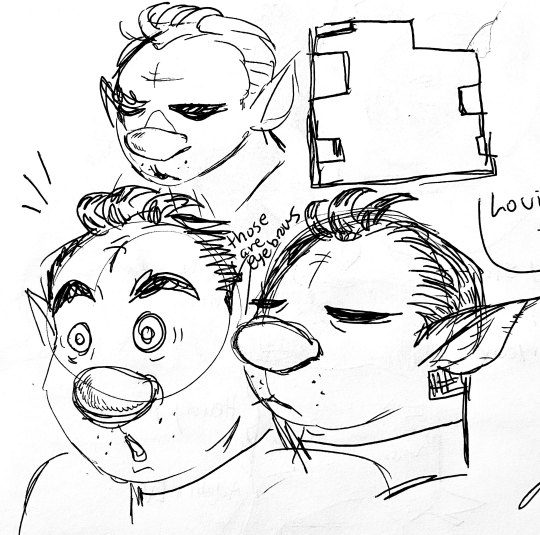

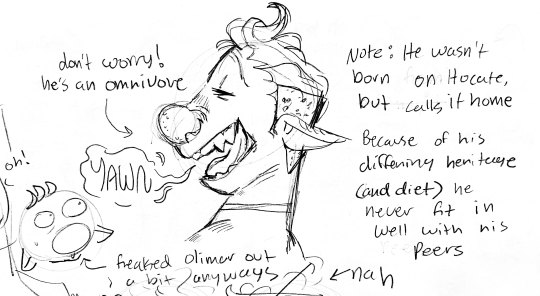
been thinking abt pikmin dudes (ty for the inspo @krizkrozapplesoz!)
[image desc in alt]
#doodles#pikmin#captain olimar#pikmin louie#made olimar look more grizzled than intended#i know hes a sweet some guy I apologize#other lil ideas inspired by what ive seen#uhhh olimar's species (i havent thought of a name yet) are highly adaptable#through the development of space travel early on in their history it just led to a bunch of evolutionary offshoots#leading to an interwoven businesses n just this cosmic net of connection#and also! the species just gaining different traits with each planet they belong to#hocatate being a desert planet lead to people uhh being made more for that enviroment#:y that and i treat their homeplanets more like nationalities than different species but thats just me#also yes god finally posting these doodles
104 notes
·
View notes
Text
Alright so we all have heard the jokes about women trying and in some cases successfully befriended a wild animal, that undoubtedly could kill them. Well my theory is Women where the ones to tame wolves.
Honestly what sounds more believable. A Male teaming up with an animal that hunts the same food as him because it's faster and better at hunting then him. Or a Female bringing home a beast of an animal because she thinks it's cute.
3 notes
·
View notes
Text
Gertrude Robinson
#the magnus archives#tma#my immortal evolutionary traits are still intact#I am unapologetic for the sympathy I lacked#I mean#are you hearing this???#hello?!#Spotify
2 notes
·
View notes
Text
You guys ever like, put yourself in a characters shoes, like REALLY imagine being in their situation
i did this last night (thinking about mimic because of course i was) and i was just imagining being in that sinkhole, not a lot to do, completely isolated, probably cold as hell down there and there isn’t exactly anywhere comfortable to rest or sit.
and i came out of that like “damn holy hell” and then i like cried or something i dunno
#mimic shenanigans#justtalkingandstuff#fnaf mimic#Holy hell why am i able to do that?#What kind of evolutionary trait allows people to do that
4 notes
·
View notes
Text
tw synesthesia post but celeste i can always sense u on my dash in a way that’s like i see/feel like a dark mauve / black ribbon like under my phone and on my hand like the cool skin of a corn snake
#not tagging u in this post you’ll find it#i think maybe my brain is taking the scenic route to tell me my mind read ur url before my dyslexic eyes did#wait. is synesthesia like an evolutionary trait in people who have a disadvantage because of eye/language issues like dyslexia#like if you are dyslexic are you more likely to have synesthesia as an evolutionary sunscreen to pale skin#should i go full science fair on this#celeste tag#synesthesia tag#purple tag? maybe i should start color tags
4 notes
·
View notes
Text
jotting stuff down abt how i think namekian physiology would work an ohhh my god i forgot how fun specbio is ....
#i was even really planning to do biospec abt it but im literally recycling my old biospec species from highschool#bcz certain things jus kinda fit. my initial plan was to jus to satisfy the little voice in my head that keeps bugging me while im trying t#watch the buff men fighting show asking me questions like “why do namekians have teeth if they dont eat.”#“why to eggs come out of the same hole that water and air goes into what an awful evolutionary trait that is”#“if namekians reproduce asexually why are they clearly displaying genetic diversity”#among other question..#charlie words
2 notes
·
View notes
Text
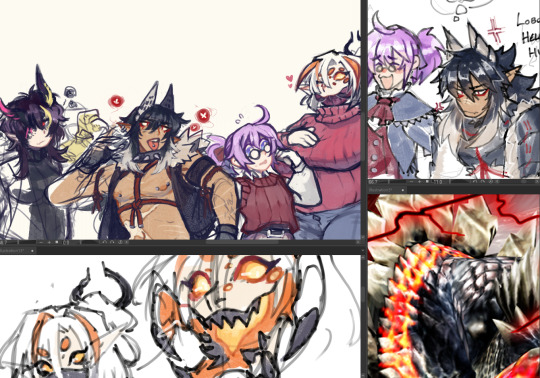
do you ever set up your workspace and become some sort of brady bunch-adjacent hell
#driftoodles#bane kniaz (oc)#penumbra#miss rakna kadaki doesnt have a name yet ive literally just been caling her miss rakna/ milfna kadaki#bane is a runaway royal doubling as a scrivener/handler in the new world. he mains insect glaive/dual blades#his bit id that he loves mondter research but is terrified of monsters in practice including domestic ones like poogie#miss rakna is a 'widowed' 'wyverian' whos been working on evolutionary neuropteron temnoceran and carapaceon#she also studies elder dragons and rare toxins.#lobo's lore is the fifth fleet caught him after he fell out of the sky and into the ocean one stormy day (theory has it he was being >#> carried off by a rathalos) and they cant rlly figure out WHAT he is bc he walks like he's a wyverian but he only has the gait and ears#he gets paired with bane as a hunter/handler duo bc lobo doesnt have the patience for other handlers.#werewyvern....hes a charge blade/insect glaive main n is always surrounded by dracophage or fulgurbugs and doesnt know why#penumbra is a frenzy researcher :]#and yes bane is the only human in the group#i wanted to draw them in modern wear with rheir more monstrous traits#but realized miss rakna needs. more spidery aspects so im not too sure where to go eith her more monstery design#monhun#uuuh#wip#this is also set to not rebloggable i just wanted to show my wip and terrible workspace rn
12 notes
·
View notes
Text
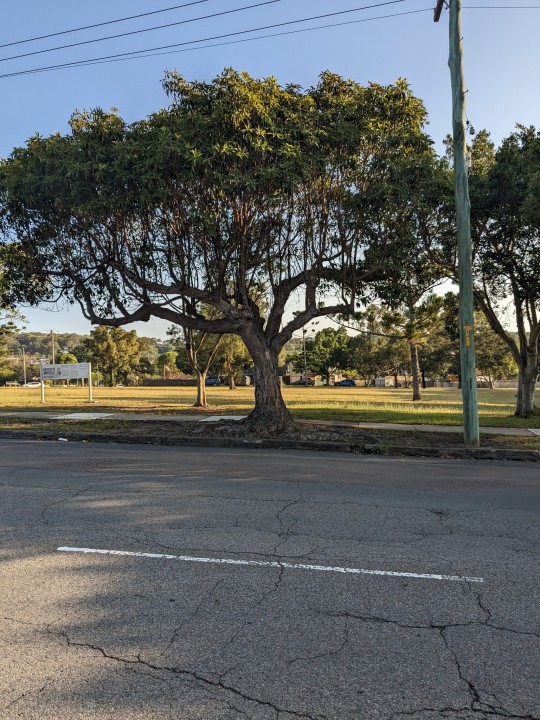
whats this guys deal
#i dont think its a native tree cause most aus native trees have evolutionary traits which help them absorb LESS sunlight#but the fact that this guys branches and leaves go straight up . like the branches fan out but then grow vertically#that seems like a trait to collect more sunshine#idk tho . idk
12 notes
·
View notes
Note
Silly Game Time: What was the most recent internet search you're comfortable with sharing?
do birds exhibit handedness?
(they do)
#it seems parrots tend to be left-handed 🤔#now I need to see how far back in the evolutionary line this trait is expressed lol#hey google do fish exhibit handedness—#thanks for the ask!!!#asks
5 notes
·
View notes